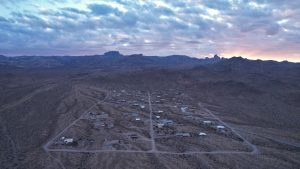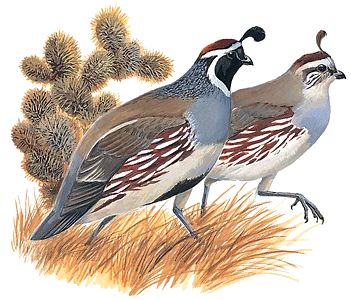Mohave Lake View Ranchos
A small community in the Black Mountain foothills of the Arizona Mohave Desert overlooking Lake Mohave only an hour and a half drive from Las Vegas, Nevada.
 An island of 64 one acre tracts with 34 homes in the Lake Meade National Recreation Area developed in 1959 by the Mohave Lake View Investment Company.
An island of 64 one acre tracts with 34 homes in the Lake Meade National Recreation Area developed in 1959 by the Mohave Lake View Investment Company.
The land was originally owned by the Santa Fe Pacific Rail Company. The Santa Fe Pacific Railroad Company (SFPR) was formed in 1897, as a subsidiary of the Atchison, Topeka, and Santa Fe Railway (often known simply as the “Santa Fe Railway”). It was primarily created to manage the Santa Fe Railway’s extensive land holdings across the western United States, particularly in Arizona, New Mexico, and California. The Santa Fe Railway had acquired vast land tracts as part of the U.S. government’s initiative to incentivize railroad expansion westward by granting land to railway companies for building infrastructure. SFPR played a key role in managing, selling, and developing these lands.
This company was instrumental in shaping development and settlement patterns throughout the American Southwest by selling land to settlers, ranchers, and developers. The SFPR also facilitated the establishment of towns and agricultural areas along rail lines. Santa Fe Pacific’s land sales spurred growth in areas like Arizona and New Mexico, fostering agricultural, mining, and urban development around rail access points, particularly in more remote desert regions.
In the 1940s, the Santa Fe Pacific Railroad Company merged back into the main Santa Fe Railway as land management needs changed. The original mission of western expansion and land settlement had largely succeeded, and the focus shifted back toward maintaining and expanding rail operations. Today, the Santa Fe Railway’s legacy persists, as its network became part of the BNSF Railway, one of the largest freight rail networks in North America.
The Mohave Lake View Investment Company, as a corporate entity, was one of several developers involved in subdividing land in Mohave County, Arizona, during a period of regional real estate expansion influenced by proximity to infrastructure and natural attractions. This particular development strategy was shaped by the surrounding natural landscape and transportation networks, which have historically played a crucial role in the area’s appeal for new residents and investors alike. Mohave County’s subdivisions, including Mohave Lake View Ranchos, were marketed with a focus on affordable land options near recreational hotspots like Lake Mohave, leveraging the area’s scenic desert environment and accessibility to the Colorado River.
The investment climate in Mohave County has generally been geared toward affordable land ownership opportunities with the potential for future appreciation, reflecting both the scenic appeal and growth prospects in the region due to its position near major transit routes like Interstate 40 and historic Route 66. This area remains attractive to a wide range of buyers, including outdoor enthusiasts and those interested in real estate investment, due to its unique mix of affordability, natural beauty, and access to recreational activities along the river and nearby lakes.
 Mohave Lake View Ranchos in Mohave County, Arizona, is a residential subdivision near Bullhead City with historical ties to real estate development around the Lake Mohave area. The land, initially open desert, began its transformation in the 20th century, influenced by the area’s proximity to major railway routes and the growth of Lake Mohave as a recreational and residential area. As nearby Bullhead City grew, developers aimed to create affordable housing and vacation properties, with scenic views of the lake and easy access to the Colorado River.
Mohave Lake View Ranchos in Mohave County, Arizona, is a residential subdivision near Bullhead City with historical ties to real estate development around the Lake Mohave area. The land, initially open desert, began its transformation in the 20th century, influenced by the area’s proximity to major railway routes and the growth of Lake Mohave as a recreational and residential area. As nearby Bullhead City grew, developers aimed to create affordable housing and vacation properties, with scenic views of the lake and easy access to the Colorado River.
Lake Mohave itself was created after the completion of Davis Dam in 1951, which spurred interest in the region for tourism, recreation, and housing. This influx of interest led to subdivisions like Mohave Lake View Ranchos, marketed as accessible desert escapes with a view of the lake and nearby recreational opportunities. Initially, small-scale ranches and vacation properties attracted buyers, eventually evolving into more organized communities as the area’s population grew in the late 20th century.
Developments like Mohave Lake View Ranchos aimed to appeal to people drawn to Arizona’s rugged landscapes and the recreational potential around the lake and river. However, further details on the Mohave Lake View Investment Company’s specific role in this development are limited. For more on Lake Mohave’s broader influence on residential development and nearby subdivisions, you might explore local historical records or real estate archives from Mohave County.
Lake Mead National Recreation Area, established in 1964, was the first national recreation area in the United States and remains a major destination for outdoor activities in the Southwest. Encompassing over 1.5 million acres in Nevada and Arizona, it includes both Lake Mead and Lake Mohave, which were created by the construction of the Hoover and Davis Dams, respectively. The recreation area provides a diverse landscape that spans desert, mountains, and lake environments, offering a range of activities from boating and fishing to hiking and wildlife observation.
The centerpiece, Lake Mead, is the largest reservoir in the United States by water capacity, although recent droughts and water management have significantly lowered its levels in recent years. The surrounding ecosystems include a variety of flora and fauna, with species adapted to the arid desert climate and riparian areas around the Colorado River.
In addition to recreational opportunities, the area is rich in cultural history, with archaeological sites that date back to prehistoric Native American civilizations. Historic sites, such as remnants of early 20th-century mining towns and structures associated with the dam constructions, provide a glimpse into the human history of the region.
Managed by the National Park Service, Lake Mead National Recreation Area plays a critical role in water conservation, ecosystem preservation, and recreation management, balancing the needs of millions of annual visitors with environmental stewardship.
Lake Mohave is a reservoir on the Colorado River, located along the border between Nevada and Arizona, within the Lake Mead National Recreation Area. The lake was created in 1951 after the completion of Davis Dam, which sits downstream of Hoover Dam near the city of Bullhead City, Arizona. Stretching 67 miles, Lake Mohave serves multiple purposes, including water storage, flood control, and hydroelectric power generation, while also supporting a diverse ecosystem and offering a wide range of recreational activities.
 Recreation on Lake Mohave includes boating, fishing, kayaking, and swimming, and it’s popular for camping and hiking in surrounding areas. The lake’s water remains at relatively consistent levels compared to Lake Mead, despite recent drought conditions affecting the Colorado River Basin. This has allowed Lake Mohave to be a steady destination for fishing, especially for species like striped bass, rainbow trout, and catfish, which are stocked by the National Park Service. The lake’s clear waters and surrounding desert landscapes attract divers and sightseers, and notable spots include Cottonwood Cove, Willow Beach, and Katherine Landing, which provide access points, boat rentals, and visitor facilities.
Recreation on Lake Mohave includes boating, fishing, kayaking, and swimming, and it’s popular for camping and hiking in surrounding areas. The lake’s water remains at relatively consistent levels compared to Lake Mead, despite recent drought conditions affecting the Colorado River Basin. This has allowed Lake Mohave to be a steady destination for fishing, especially for species like striped bass, rainbow trout, and catfish, which are stocked by the National Park Service. The lake’s clear waters and surrounding desert landscapes attract divers and sightseers, and notable spots include Cottonwood Cove, Willow Beach, and Katherine Landing, which provide access points, boat rentals, and visitor facilities.
Beyond recreation, Lake Mohave’s ecosystem includes habitats for a variety of species, including bighorn sheep, migratory birds, and native fish species. Its riparian zones and nearby wetlands are essential for regional wildlife, supporting diverse flora and fauna in the arid environment.
